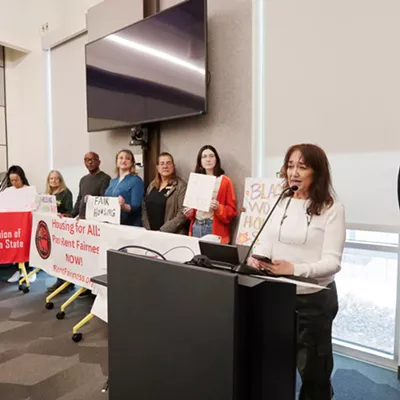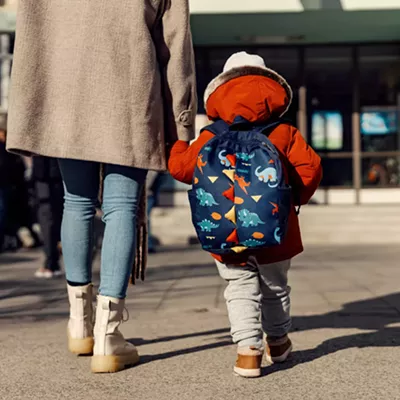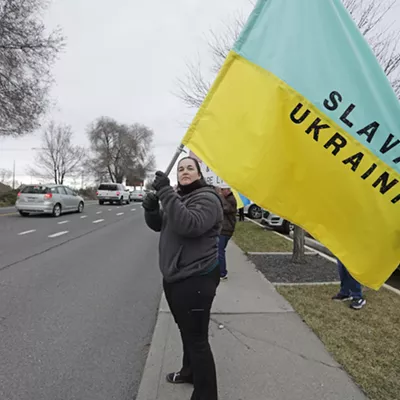NICHOLAS
Sironka is far from home — a town in Kenya 35 kilometers south of Nairobi that would be a warm and mild contrast to the frozen snow blanketing the Whitworth campus. As a Fulbright scholar, Sironka teaches batik art and Maasai culture at the college in addition to his own ongoing work as an artist. His vibrant, color-saturated batiks represent Maasai values and traditions, and have been exhibited in the Kenya National Museum, the British Council in Nairobi, and more recently at Whitworth College. It was
"I watched him work, and what he was making was the kind of batik you see as a cheap craft," says Sironka. "I wanted to do something better. I wanted to do batik as an art form."
After a fall quarter exhibit at Whitworth's Koehler Gallery, Sironka's work will be shown through January and part of February at the Spokane Art School, where he will also teach a one-day batik workshop.
Batik uses cold water fabric dyes and hot wax on
"I remember seeing a woodcarving, the kind of thing a tourist might buy, of a Maasai family where the man and woman are holding hands," he says. "In Maasai cultures, you don't find them kissing in public or holding hands. That's purely a Western thing."
The confusion doesn't end there. "The Maasai live in a little igloo-shaped structure made of earth. The structure is about seven feet high and the doorway is usually five and a half to six feet high, so you have to bend to go inside," he explains. "Maasai tribesmen leave their spears outside, by the door, which Westerners have often interpreted as a sign to the other tribesmen that he is in there, having sex with the woman whose home it is. To us, that is an insult. What the spear really means is that it's very dark inside, and just inside the entrance, you have to make a sharp turn to the right. The spear is too long and too dangerous to bring inside."
What is most important in the Maasai culture, and in Sironka's life and art, is the concept of respect, which he says permeates every aspect of Maasai life and which he also finds sorely missing in the United States.
"In Kenya, we had American TV programs, Happy Days, The Waltons, and the young people in these shows were still respectful," he says. "But it is not that way in America now. What happened? I think one of the problems is that parents allow too much freedom. Some freedom is not bad. But when children are allowed to shout back, and allowed to forget respect for their elders, this creates problems."
Sironka is a natural teacher. During the course of our interview and photo shoot, he shows us an impressive two-volume book on African cultures, explains how lions are still hunted by the Maasai (the encircled lion, he explains, can tell which one of the hunters is the most cowardly and will make a break for freedom there first), shows us how to iron the wax out of a finished batik and displays a beaded, giraffe tail wisk. Throughout, he explains what the details in his work — a cow skull, the touch of an elder's hand on a child's head — mean to him as a Maasai. He's currently at work on writing placards that will go next to each batik that will help explain what the viewer is seeing. And while Sironka is in the United States to educate Americans about Maasai culture and contemporary Kenyan life, his ultimate goal is to help further the education of Kenyan youth for the good of his homeland.
"I am hoping that while I am here, I will find people who will help us to sponsor one girl and one boy to come to the United States after high school to attend university," he says. "If we set it up to make all the Maasai children compete, they will try to be very good in their studies. And this would then be beneficial to the Maasai. Their children would get an education, and the one condition for the two winners is that after they have come to America, they will return to Kenya to share what they have learned."
"Work by Nicholas Sironka" is on view at the Spokane Art School Gallery from Jan. 10-Feb. 9. Artist reception: Feb. 2 from 5-9 pm during the Visual Arts Tour. He also offers a Maasai master class and batik workshop on Saturday, Jan. 27, from 10 am-2 pm. Cost: $50, plus $5 lab fee. Call: 328-0900.
Full Visual Display
While the view from LOUISE KODIS's front window is one of a snow-buried South Hill street, the surroundings inside are like a spring day in full bloom. The organic shapes of leaves and petals tease life from the bright fabrics and handmade ribbons of
Kodis is readying herself and her work for her upcoming show, "Full Public Disclosure," at the Chase Gallery.
" 'Full Public Disclosure' refers to a combination of things," she explains. "When we first planned the show, it was late in summer and as a nation, we were in the throes of pre-election politics, as a city we were in the throes of what's going on in City Hall. A great deal of my work has been exhibited in and commissioned for display in public places. And my exhibit at the Chase will be not only finished
Much of the work for this show is inspired by the natural world. Free Fall is a five-piece work, consisting of long banners of silk with leaf images borrowed from
"I have long been fascinated with the transparent quality of fabric," she says. "How light falls on it, and how
Likewise, the fantasy swings, which will be three in number, have a magical quality that nevertheless keeps its feet on the ground. While the swings are translucent and delicate, they're decorated with leaf and bloom shapes and hung by handmade fabric ropes that give the finished pieces a sense of stability.
"The ropes precipitated a lot of hand-sewing," admits Kodis.
The practical joy of a simple pocket is not lost on
"Haven't you always wondered what people have in their pockets?" she says. "I can't stand clothes without pockets. They're so useful, and they always have such fascinating things inside."
The show also includes collaborative work with two of the most important men in her life, her glassworking partner, David Glass, and her brother,
For her numerous commissions,
"The way these are structured is meant to suggest the properties of bent and folded paper," she says. "You know how we fold maps and never get them right? That's what I tried to capture here. I've never made a fabric map before, and this is my interpretation of a section of state map."
"Full Public Disclosure," a display of works by Louise Kodis, shows at the Chase Gallery in City Hall, 808 W. Spokane Falls Blvd., through Feb. 16. Artist reception: Feb. 2 from 5-9 pm during the Visual Arts Tour. Call: 625-6050. &
















